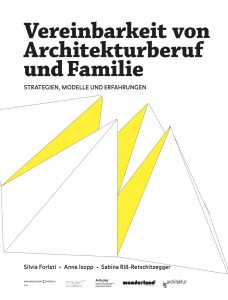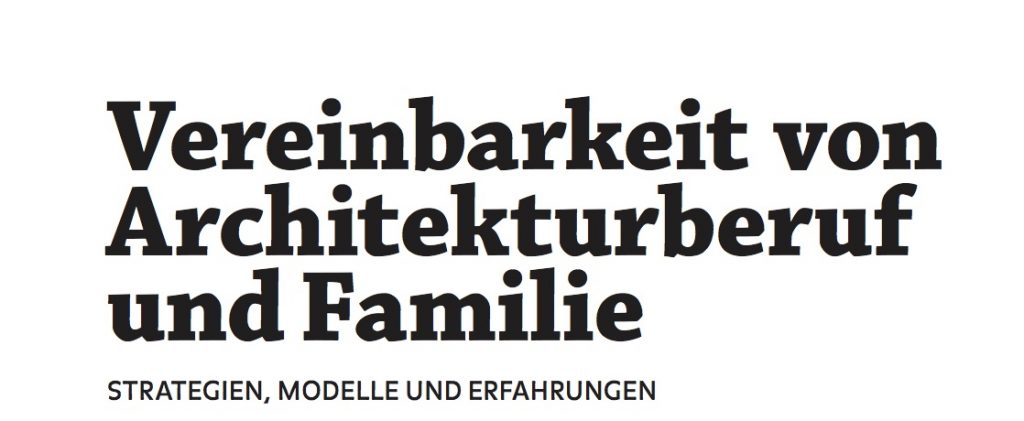Reconciling architectural profession and family life. Strategies, models and experiences.
by Silvia Forlati, Anne Isopp, Sabina Riß-Retschitzegger
Central to the research ‘Vereinbarkeit von Architektenberuf und Familie‘ (at the moment only available in German) was the question of why the number of female architects in Austria is relatively low and which strategies and models are available to reconcile profession and family life. The publication highlights factors contributing to a satisfactory combination of work and family life and also issues requiring further attention. Expert’s contributions provide a scientific reference framework. It is obvious that professional decisions do affect family life and vice versa. One take thing as they come or make conscious decisions to achieve a satisfactory work-life balance. The output of our research is intended to support conscious decisions making and raise specific awareness on the reconciliation of architectural profession and family life. Digital copies can be downloaded from this website and hard copies can be ordered at [email protected]
The project was funded by the grant ‘Schütte-Lihotzky-Stipendium 2014’ of the Austrian Federal Chancellery, Federal Chamber of Architects and chartered Engineering Consultants) and the City of Vienna Women’s Municipal Department (MA 57).
(scroll down for german version)
Background
The question of how to reconcile work and family life is shared by many professions- Yet for the architecture profession, because of its specific working conditions, reconciliation appears to be particularly difficult : predominantly small practices- less than 3% European practices are estimated to be larger than six people (ACE 2015)- , with long working hours, low pay and precarious employment. Due to these conditions, architects being the main child-carer in their family (still mostly women) often decide to continue practicing in a limited way or change profession. This might help to explain why the number of European female architects is only 39% and in Austria 18%, even if by now there are more female architecture students than male ones.
Models and strategies for the reconciliation of architectural profession.
The study’s aim is to evaluate the impact of the specific conditions in architecture on the reconciliation of professional and family life, and the strategies developed by Austrian architects. On the basis of 33 case-studies (interviews and questionnaires) it is possible to reflect on which factors contribute to a satisfactory combination of work and family life and which issues require further attention. A brief overview of four other European countries shows how advanced approaches to gender equality positively influence work-life balance also for architects.
No matter if being employed, working free-lance or running one`s own practice, the chosen mode of work has a strong influence on reconciliation. So does working time (full, part or flextime) and spatial organization (from live-work models, to home office, to traditional office spaces). As good solutions are mostly individually defined, we have developed a kit that allows to see how a series of alternative individual choices, from professional to private ones, work together and effect the way professional and family life are brought together.
Experts input
The difficulty of bringing together professional and family life also lies within political and societal contexts defining much of how families can organize working and family time, (not only in the choices individually available). In Austria traditional gender roles- according to which women are automatically responsible for child caring- are still very widespread. Long maternity leaves and part-time working are the main solutions supported at political level. In Austria working women earn 24% less than working men, thereby Austria is second last in Europe just ahead of Estonia, as indicated by the sociologist Christoph Reinprecht in his contribution to this study. While many women chose to study architecture because it is seen as a liberal profession reality reveals a different truth. Reinprecht highlights the need to rethink the unwritten rules and behaviors patterns of the architectural profession, only then it will be possible to change the gender roles. The culture of long working hours, as further suggested by the researcher Ulrike Papouschek in her contribution, plays a fundamental role in this perspective. The acceptance that architecture can happen within defined working hours is a fundamental condition to achieve balance between professional and family life. The architect Christoph Achammer is convinced that by changing this attitude more women could successfully remain within the profession – without renouncing children and family responsibility. He therefore has introduced a flexible working scheme in his company with only three core hours required per day.
Next steps
Political change can be slow and out of reach, yet architects themselves can take responsibility for new approaches in daily practice. It requires a critical examination of the culture of long working hours within the architectural profession and the ideal of the architect as an artist. Furthermore architects – to be should become aware of this important issue and already develop a strategic approach in how to reconcile the profession with family-life. This work intends to support the profession`s move towards these new directions.

‚Vereinbarkeit von Architektuberuf und Familie‘
Edited by Silvia Forlati, Anne Isopp, Sabina Riß-Retschitzegger for wonderland platform for European architecture.
Vereinbarkeit von Architekturberuf und Familie
Strategien, Modelle und Erfahrungen
Die Studie zur „Vereinbarkeit von Architektenberuf und Familie“ beschäftigt sich mit den Fragen, warum es so schwierig ist Architekturberuf und Familie unter einen Hut zu bringen, warum es so wenig Architektinnen in Österreich gibt und welche Strategien und Modele funktionieren, um Beruf und Familie unter einen Hut zu bringen. Hierfür wurden Interviews geführt und Fragebögen ausgewertet und 33 Fallbeispiele von österreichischen ArchitektInnen zusammengetragen. In der nun erschienenen Broschüre kann man anhand von Interviews, Steckbriefen und Strategiemodellen nachlesen wie und unter welchen Umständen ein zufriedenstellendes Familien- und Berufsleben erreicht werden kann, beziehungsweise in welchen Bereichen Handlungsbedarf besteht. Expertentexte stellen diese individuellen Erfahrungen auf ein wissenschaftliches Fundament. Fest steht: Berufliche Entscheidungen haben immer Auswirkungen auf das Familienleben und umgekehrt. Man kann solche Entscheidungen dem Zufall überlassen oder man kann bewusst Entscheidungen fällen, um mehr Zufriedenheit im Zusammenspiel von Beruf und Familie zu erreichen. Die Ergebnisse der Studie sollen bei einer bewussten Entscheidungsfindung helfen und zu einer Sensibilisierung für das Thema der Vereinbarkeit von Beruf und Familie in der Architektur beitragen.

Silvia Forlati, Anne Isopp, Sabina Riß-Retschitzegger
Das Projekt „Vereinbarkeit von Architekturberuf und Familie“ wird gefördert durch das Schütte-Lihotzky-Stipendium 2014, die Bundeskammer der Architekten und Ingenieurkonsulenten und die Frauenabteilung der Stadt Wien MA 57.
Die Broschüre „Vereinbarkeit von Architektenberuf und Familie„ kann hier heruntergeladen werden oder zu einem Selbstkostenpreis von 12,- Euro bestellt werden (email an: [email protected]).

